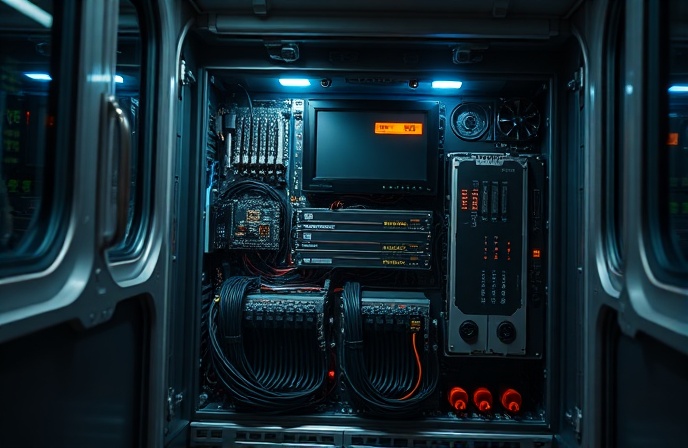Alstom’s Shanghai Rail Win: APM Tech & Green Transit

This article examines the strategic significance of Alstom’s recent five-year maintenance contract win in Shanghai, China. The contract, awarded to CRRC Puzhen Alstom Transportation Systems (PATS), a joint venture between Alstom and CRRC, covers comprehensive maintenance of the Shanghai Pujiang Line’s core electromechanical systems. This deal represents more than a simple maintenance agreement; it underscores a growing trend in the rail industry towards full lifecycle service contracts and highlights Alstom’s commitment to the Chinese market and its ongoing contribution to sustainable urban transportation solutions. The Pujiang Line, a significant example of Automatic People Mover (APM) technology, provides a compelling case study for examining the evolving landscape of rail maintenance and the increasing importance of technological innovation in improving efficiency and sustainability within urban rail networks. This analysis will delve into the specific aspects of the contract, its broader implications for the rail sector, and the technological advancements incorporated into the Pujiang Line’s design and operation.
A Comprehensive Maintenance Agreement
The five-year contract awarded to PATS encompasses a broad range of maintenance tasks, including the daily upkeep of the Automatic People Mover (APM) vehicles, signaling systems, and extensive monitoring and communications equipment. This “full lifecycle” approach represents a departure from traditional, fragmented maintenance contracts, offering the Shanghai Shentong Metro Group (SSMG) a streamlined and potentially more cost-effective solution. By entrusting all core electromechanical system maintenance to a single entity, SSMG benefits from improved coordination, enhanced accountability, and a potentially reduced risk of system failures due to integration issues. This approach also allows for proactive maintenance strategies, leveraging predictive analytics and data-driven insights to optimize maintenance schedules and minimize downtime.
Technological Advancements in the Pujiang Line
The Pujiang Line, as Shanghai’s first APM line, showcases several technological advancements aimed at improving efficiency and sustainability. The APM vehicles utilize lightweight body designs, regenerative braking systems (recovering energy during braking), and sophisticated power management systems to significantly reduce energy consumption. The integration of high-reliability explosion-proof steel-rim tires further enhances operational safety and reliability. These combined technologies contribute to a greener footprint for the line, aligning with both Alstom’s and the Chinese government’s sustainability goals. The success of these technologies on the Pujiang Line serves as a blueprint for future APM deployments globally, demonstrating the potential for significant environmental benefits and cost savings.
Strategic Implications for Alstom and the Rail Industry
The PATS contract demonstrates Alstom’s strong market position in China and its commitment to long-term partnerships. Securing a full lifecycle maintenance contract for the Pujiang Line signifies a significant endorsement of Alstom’s capabilities and expertise. This success builds upon Alstom’s previous projects in China, which include delivering APM systems to multiple airports and providing Innovia APM 300 systems to the Hong Kong International Airport (HKIA). This consistent success in the Chinese market signals Alstom’s ability to deliver high-quality, sustainable rail solutions to meet the demands of a rapidly growing urban transportation sector. Furthermore, this contract highlights the growing trend in the rail industry toward full-lifecycle service contracts, a model that fosters long-term relationships and facilitates continuous improvement through data-driven insights.
Green and Intelligent Transportation Solutions
Alstom’s commitment to delivering “greener and smarter mobility” solutions is directly reflected in the Pujiang Line project. The advanced technological features of the APM system, combined with the comprehensive maintenance contract that ensures optimal performance, contribute to a more sustainable and efficient transportation system. This emphasis on sustainability aligns with global efforts to reduce carbon emissions and promote environmentally friendly transportation options. The success of the Pujiang Line serves as a model for future projects, demonstrating how technological innovation and proactive maintenance strategies can work in tandem to create truly sustainable urban rail networks. This approach fosters a circular economy model within the rail industry, reducing waste and extending the lifespan of assets.
Conclusions
Alstom’s win of the five-year maintenance contract for the Shanghai Pujiang Line’s core electromechanical systems, awarded to its joint venture PATS, signifies a crucial milestone in both Alstom’s Chinese market strategy and the broader evolution of the rail maintenance industry. This “full lifecycle” contract represents a significant shift toward comprehensive service agreements that optimize efficiency, enhance sustainability, and minimize operational risks for rail operators like the Shanghai Shentong Metro Group (SSMG). The Pujiang Line itself serves as an excellent case study, showcasing technological advancements like lightweight vehicle designs, regenerative braking, and advanced power management systems. These contribute significantly to reduced energy consumption and a smaller environmental footprint, aligning with global sustainability goals. The contract’s success reinforces Alstom’s commitment to providing high-quality, sustainable, and intelligent transportation solutions. The success of this project in China, building on previous successful deployments of APM systems in various locations across the country, clearly positions Alstom as a leading innovator and provider of rail infrastructure solutions. The implications extend beyond this particular contract; it signals a growing industry trend towards holistic lifecycle maintenance, emphasizing proactive strategies, data-driven decision-making, and the integration of advanced technologies to optimize operational efficiency and enhance the sustainability of urban rail systems worldwide. For readers, this case study underscores the importance of innovative technological solutions, strategic partnerships, and comprehensive maintenance programs in building robust and sustainable urban transit systems. The future of rail lies in integrating these elements for a more efficient, cost-effective, and environmentally friendly approach to public transportation.


